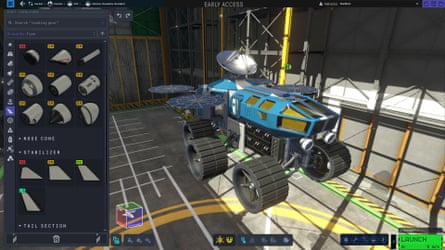When Dr Uri Shumlack was contacted by a video game developer who wanted to discuss his work on interstellar propulsion, for a game about spaceflight, he was wary. A professor of aeronautics and astronautics at the University of Washington, he was a busy individual, and not exactly an avid gamer. He asked some of his engineering undergraduates whether they had heard of a game called Kerbal Space Program, only to discover that half the class were there because of the game.
First playable in 2011, Kerbal Space Program is an idiosyncratic and extremely difficult video game that involves getting little green aliens off the surface of their planet using rockets that you must cobble together from a library of parts. To do this, though – and leave the launchpad without exploding – you have to develop a pretty good understanding of the physics of space travel, calculating orbit trajectories and figuring out how much fuel you need, and whether you can carry it without messing up your thrust-to-weight ratio. It is beloved by space and astrophysics enthusiasts, who have posted thousands of hours of gameplay video showing off their unlikely crafts and ambitious missions in this simulated solar system.
Some of those players end up in classes such as those of Dr Shumlack. Nate Simpson is creative director of the follow-up game, Kerbal Space Program 2, developed by Intercept Games As he put it at an event at the European Space Agency’s research and technology centre in the Netherlands, this game no longer just replicates the human spaceflight endeavour: it’s now part of it. Some of the physicists, engineers and astronauts who will be working at the ESA over the next decade will have developed a passion for spaceflight while trying to safely deposit comical little astronauts on the moon in landers they designed.
I am here to play Kerbal Space Program 2, which recently launched in early access on PC games storefront Steam. Made by a new team, it feels pretty early and unstable to play, but over the next couple of years it hopes to offer players the chance to go even further than the Kerbal solar system and its celestial bodies, travelling between stars.
To simulate this, the team has worked with experts from everywhere, from the ESA to fusion scientists working on near-future fuel technology. One member of the Intercept Games development team is a former engineer who worked with the Canadian space agency on ground missions; another came to the studio after running an educational podcast series on space exploration. “The reality of space travel is sometimes stranger than fiction,” says lead designer Shana Markham, who joined Intercept Games in 2019. “As a sci-fi nerd, being able to see what people really have to think about was intriguing.”
My experience of the game is not atypical, and boils down to building a rocket, adding some cool wings to it on a whim, crashing, tinkering, making minor adjustments, crashing again, removing the wings and adding more thrusters, crashing once more, and eventually feeling such elation when I make it out of the planet’s atmosphere for the first time that I forget to adjust my trajectory correctly and plummet back to Earth instead of achieving a stable orbit. As in real life space flight, a tiny miscalculation can throw the whole mission, and adjusting even the smallest thing on the fly requires a flurry of high-speed calculations (though, unlike in real life, here you can pause time to sort things out). Later, using a save file provided from the developer, I land a rover on the game’s equivalent of Mars, but within 20 seconds I flip it and get stuck upside down.
After half a day with this game (and a couple of weeks with the original, years ago), I have pretty much become a moon-landing denier, because it now seems even more unfathomable that mere humans could possibly have got a real craft into space and back again without everything going tits-up. But I am not a rocket scientist. Talking to those who are and work here at the ESA, many of whom have played the game over the years, they are amused and impressed by how accurate it is. It is not quite an exact physics simulation of spaceflight, but it is close.
“In some cases we are very true to life,” says Markham. “For example, fuel tanks empty as you’re going, and that actually makes your vehicle lighter and changes its flight characteristics. But then, if you look at something like how you maintain communications back home, that’s less authentic. Instead, it’s coming from a place of sparking curiosity … the game has to be fun!” Because the game is one continuous simulation, the whole thing is an unimaginably enormous technical challenge. “All of the systems have to work in concert, all the time, from launch to travel to landing on another planet to planting a flag and coming home again,” says Markham.
Ever since 1984’s Elite, games have been trying to capture the fantasy of space travel, sometimes catching the imaginations of players who go on to have careers in real-world physics, engineering and aeronautics. Kerbal Space Program is more interested in capturing the reality of space-travel, little green astronauts notwithstanding, and in doing so it has perhaps been an even greater influence on its players. “It’s really rare to see a game have this sort of impact on people’s lives, on the real world,” says Markham. The ESA is working on getting the first Europeans on to the surface of the moon; no doubt some of the people who work on that mission will have achieved it in this game first.
Keza MacDonald attended a press trip to the European space research and technology centre in the Netherlands with other journalists and streamers. Travel and accommodation expenses were met by Kerbal Space Program 2’s publisher, Private Division.

